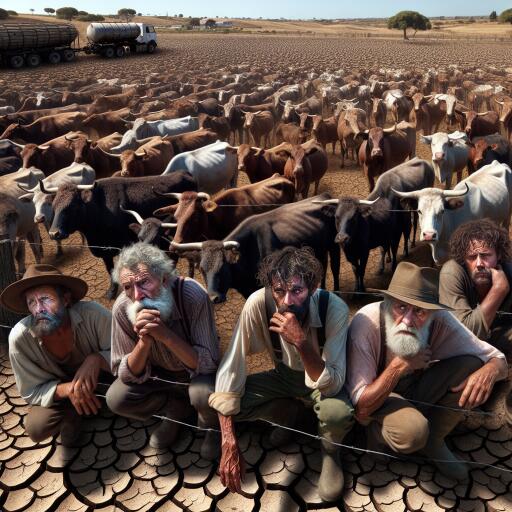
Extended Drought Parches Sicily, Farmers Face Tough Decisions
In the sweltering heat of a July afternoon in southern Sicily, the arrival of a water truck on Liborio Mangiapane’s farm brings a temporary sigh of relief. The truck discharges its precious cargo into a smaller cistern, a lifeline for Mangiapane’s 250 cattle and sheep. Yet, this 10,000-liter delivery will evaporate by tomorrow, swallowed by the parched throats of livestock and the bone-dry earth.
This scene is a grim tableau of the struggle faced by Sicilian farmers, caught in the crushing grip of an extended drought that has left much of the land barren. A year with scarcely any rain, coupled with record-breaking temperatures, has ravaged the region’s hay production, putting immense pressure on farmers like Mangiapane. The daily quest for water has become a frantic routine of phone calls, lengthy drives, and anxious waits.
The specter of having to sell off livestock looms large if the rain doesn’t break by the end of August. “We are in a moment of extreme heat, and therefore animals need a lot of water,” Mangiapane explains, highlighting the dire need to prevent animal suffering and maintain basic hygiene.
Sicily’s predicament is stark. The island, a crucial agricultural hub, has seen its fodder production plummet by 70%, as reported by Coldiretti, Italy’s leading farmers association. The drought has drained the main water basins, with water rationing implemented as a desperate measure.
The drought is not only a crisis for livestock farmers but also threatens Sicily’s staple crops. The island contributes 20% of Italy’s durum wheat for pasta, a production now endangered, potentially increasing reliance on imports. Additionally, the drought could adversely affect upcoming olive oil and peach harvests, with the extreme heat already accelerating the grape harvest by nearly four weeks.
In response, the national government declared a state of emergency earlier in the year, allocating funds for emergency water supplies, the drilling of new wells, and the repair of leaking aqueducts. Efforts to mitigate the situation also include the donation of fodder and financial subsidies for farmers by Coldiretti and regional initiatives.
The scarcity of rainfall, up to 60% below average in some parts, and soaring temperatures have turned once-reliable water sources into distant memories. Luca Cammarata, a farmer in the province of Caltanissetta, one of the hardest-hit areas, recounts how his sheep struggle to find water where there used to be plenty.
The dire situation is encapsulated by the state of Lake Pergusa, which has shriveled to a mere puddle, its ecological role as a haven for migratory birds jeopardized.
Mangiapane, looking out from his barn at a once water-abundant pond now resembling a dry football pitch, reflects on the future with trepidation. Despite the onset of the winter rainy season in August, optimism is cautious at best, with the previous year’s efforts yielding “zero profits.”
Local authorities are taking measures like opening new wells and fixing desalination plants to alleviate the situation. Critical aquifers and wells are being tapped, and the first Italian navy tanker ship has docked to distribute millions of liters of water to the parched regions.
Households and farms, while main aqueducts are being repaired, rely on tanker deliveries to cope with water distribution rationed to mere hours a week. The efforts underscore the challenges and the potential for solutions in adapting to what may well be the new climate reality.
As Sicily grapples with this “new normal” of climate variability, there’s an emerging dialogue about water usage priorities and agricultural practices, framing a narrative of resilience and adaptation in the face of escalating climate challenges.





Leave a Reply